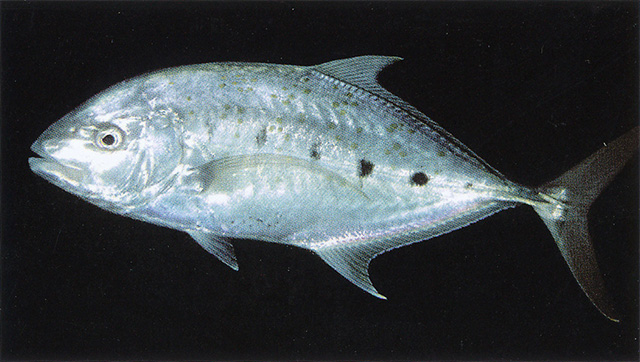| Carangidae (Jacks and pompanos), subfamily: Caranginae |
| 120 cm FL (male/unsexed); max.weight: 18 kg |
|
reef-associated; marine; depth range - 100 m |
| Indo-West Pacific: Red Sea and the East Africa to Palau and New Caledonia, north to Ryukyu and Ogasawara islands (Ref. 559, 26066), south to Australia. Recently reported from Tonga (Ref. 53797). |
|
Dorsal spines (total): 9-9; Dorsal soft rays (total): 25-30; Anal spines: 3-3; Anal soft rays: 21-26; Vertebrae: 24-24. This species is distinguished by having the following characters: body subovate and compressed, becoming elongate-ovate and slightly subcylindrical with age; profile of head and nape slightly angular becoming more steep with age; mouth cleft of adults distinctly below level of eye; D1 VIII, D2 I,25-30, lobe of second dorsal fin shorter than head length; A II (2 detached spines) + I, 21-26 (rarely 25 or 26); gill rakers (including rudiments) 6-8 + 17-21 = 22-27; vertebrae 10 + 14; straight part of lateral line with 18-27 scales followed by 15-21 small scutes; breast naked ventrally to distinctly behind origin of pelvic fins; breast squamation variable laterally, either separated from naked base of pectoral fins by a moderate to very narrow band of scales or naked area of breast uninterrupted to naked base of pectoral fins; colour of adults iridescent blue-green above, silvery below; with numerous small gold or brassy spots mainly on dorsal half; large adult with 3 (to 5) irregular black blotches on flanks (sometimes very indistinct or absent, the first below dorsal-fin lobe, the second at inflection point of lateral line, and the third slightly anterior to midpoint of straight part of lateral line (Ref. 9894, 90102).
Description: Both jaws with bands of villiform teeth, the bands widest anteriorly; vomerine tooth patch ovate, without a posteromedian extension. Lateral line anteriorly with a low regular arch, with junction of curved and straight parts below vertical from between 13th-16th soft rays of second dorsal fin; chord of curved part of lateral line longer than straight part of lateral line, contained 0.7 to 0.95 times in straight part. Opercular spot dusky and inconspicuous; dorsal and anal fins dusky yellow, the latter with leading edge and distal margin whitish blue; caudal fin olive-yellow with upper leading edge and trailing edges dusky; pelvic fins whitish blue (Ref. 9894). |
| Adults prefer rocky and coral reef areas, but also found on offshore banks (Ref. 30573). They occur singly or in small to large schools (Ref. 9710, 48635, 90102). They feed on small invertebrates and fishes (Ref. 5213). |
|
Least Concern (LC); Date assessed: 09 March 2015 Ref. (130435)
|
| harmless |
Source and more info: www.fishbase.org. For personal, classroom, and other internal use only. Not for publication.

